
FLU77-4 or equivalent

SECTION 307-05: Automatic Transaxle/Transmission External Controls
| 2014 Flex Workshop Manual
|
DIAGNOSIS AND TESTING
| Procedure revision date: 05/02/2013
|
 | Fluke 77-IV Digital Multimeter
FLU77-4 or equivalent |
 | Vehicle Communication Module (VCM) and Integrated Diagnostic System (IDS) software with appropriate hardware, or equivalent scan tool
|
Inspection and Verification
Visual Inspection Chart
| Mechanical | Electrical |
|---|---|
|
|
DTC Chart
DTC Chart
| DTC | Component | Description | Condition | Symptom | Action |
|---|---|---|---|---|---|
| B2572 | Brake Shift Interlock Actuator (BSIA) | Brake shift interlock output circuit failure | The associated circuitry connected to the BCM or fuse, or the BCM itself may have an issue causing a BSIA concern. | BSIA is inoperative or does not operate correctly. | GO to Pinpoint Test A . |
Symptom Chart — External Controls
| Condition | Possible Sources | Action |
|---|---|---|
|
| |
|
| |
|
|
|
|
| |
|
|
|
|
| |
|
|
Symptom Chart — NVH
| Condition | Possible Sources | Action |
|---|---|---|
|
|
|
Electrical Connectors
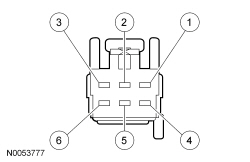
| Pin Number | Circuit | Circuit Function |
|---|---|---|
| 1 | CET53 (BU/OG) | Brake Shift Interlock Actuator (BSIA) power circuit |
| 2 | CDC41 (WH/BN) | PARK detect signal to ignition switch |
| 3 | VLN04 (VT/GY) | PARK detect signal to Instrument Cluster (IC) |
| 4 | GD375 (BK/BU) | Ground |
| 5 | CET34 (BN/GN) | Transmission Control Switch (TCS) signal |
| 6 | CBP30 (YE/BU) | TCS power circuit |
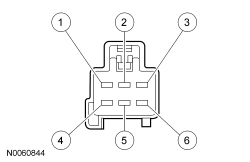
| Pin Number | Circuit | Circuit Function |
|---|---|---|
| 1 | OG | Brake Shift Interlock Actuator (BSIA) power circuit |
| 2 | RD | PARK position signal to ignition switch |
| 3 | BU | Power to PRNDL bulb |
| 4 | BK | Ground |
| 5 | WH | Transmission Control Switch (TCS) signal |
| 6 | BK | TCS power circuit |
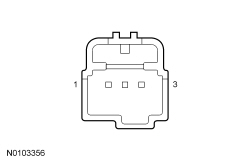
| Pin Number | Circuit | Circuit Function |
|---|---|---|
| 1 | — | Upshift signal |
| 2 | — | Ground supplied from PCM |
| 3 | — | Downshift signal |
NOTE: Both RH and LH paddle shifter connectors are the same and share the same circuits.
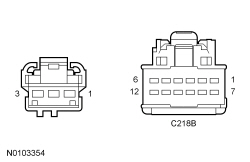
| Paddle Shifter Connector Pin Number | Steering Wheel C218B Pin Number | Circuit Function (Color) |
|---|---|---|
| 1 | 6 | Upshift signal (VT/OG) |
| 2 | 2 | Ground supplied from PCM (GY) |
| 3 | 12 | Downshift signal (YE/RD) |
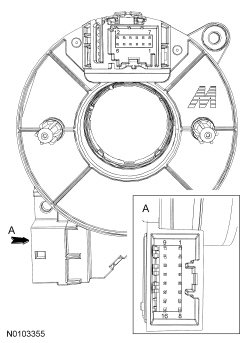
| Clockspring Pin Number C218B End Component Side | Clockspring Pin Number C218A End Component Side | Circuit Function |
|---|---|---|
| 6 | 3 | Upshift signal |
| 2 | 7 | Ground supplied from PCM |
| 12 | 11 | Downshift signal |
Pinpoint Tests
Refer to Wiring Diagrams Cell 29 , Transmission Controls — 6 Speed for schematic and connector information.
Refer to Wiring Diagrams Cell 37 , Shift Interlock for schematic and connector information.
| Test Step | Result / Action to Take |
|---|---|
| A1 TEST THE BRAKE LIGHTS | |
| Yes
GO to A2 . No REFER to Section 417-01 . |
| A2 TEST BCM FUSE 18 (10A) | |
| Yes
GO to A3 . No INSTALL a new fuse. GO to A3 . |
| A3 TEST THE BSIA POWER CIRCUIT | |
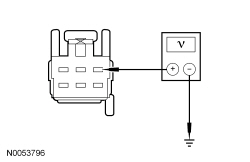 | Yes
GO to A6 . No GO to A4 . |
| A4 TEST THE BSIA POWER CIRCUIT FOR A SHORT TO GROUND | |
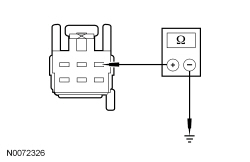 | Yes
GO to A5 . No REPAIR circuit CET53 (BU/OG) for a short to ground. TEST the system for normal operation. |
| A5 TEST THE BSIA POWER CIRCUIT FOR AN OPEN | |
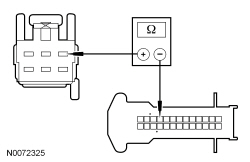 | Yes
INSTALL a new BCM . TEST the system for normal operation. No REPAIR circuit CET53 (BU/OG) for an open. |
| A6 TEST THE BSIA GROUND CIRCUIT | |
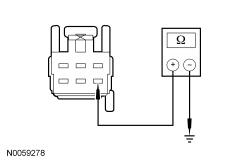 | Yes
GO to A7 . No REPAIR circuit GD375 (BK/VT). TEST the system for normal operation. |
| A7 TEST THE BSIA WITH THE SELECTOR LEVER CABLE DISCONNECTED | |
| Yes
Check selector cable function and adjust the cable If necessary. REFER to Selector Lever Cable Adjustment In this section. No INSTALL a new selector lever. REFER to Selector Lever in this section. |
| Test Step | Result / Action to Take |
|---|---|
| B1 TEST THE IC | |
| Yes
REFER to Section 413-01 . No GO to B2 . |
| B2 CHECK FOR VOLTAGE SUPPLY AT THE SELECTOR LEVER CONNECTOR | |
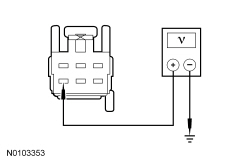 | Yes
GO to B3 . No REPAIR circuit CBB46 (WH/BU) for an open. RECONNECT all components. TEST the system for normal operation. |
| B3 TEST THE TCS SIGNAL CIRCUIT FOR AN OPEN | |
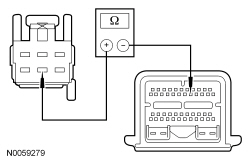 | Yes
GO to B4 . No REPAIR circuit CET34 (BN/GN) for an open. RECONNECT all components. TEST the system for normal operation. |
| B4 TEST THE TCS | |
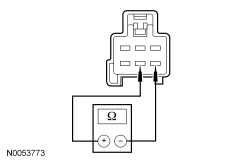 | Yes
INSTALL a new PCM. REFER to Section 303-14 . TEST the system for normal operation. No INSPECT the selector lever wiring harness for damage and REPAIR as necessary. If the selector lever wiring harness is not damaged, INSTALL a new selector lever knob. REFER to Selector Lever Knob in this section. TEST the system for normal operation. |
| Test Step | Result / Action to Take | ||||||||||||||||||||||||
|---|---|---|---|---|---|---|---|---|---|---|---|---|---|---|---|---|---|---|---|---|---|---|---|---|---|
| C1 TEST THE PADDLE SHIFTER CIRCUITS FOR AN OPEN | |||||||||||||||||||||||||
NOTE: Both RH and LH paddle shifter connectors are the same and share the same circuits.
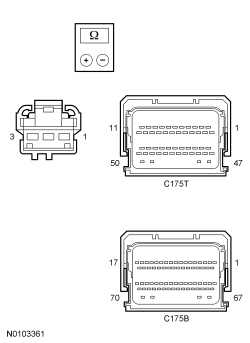
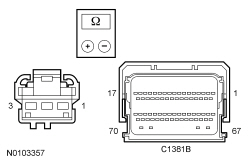 | Yes
GO to C4 . No GO to C2 . | ||||||||||||||||||||||||
| C2 TEST THE STEERING WHEEL WIRING HARNESS PADDLE SHIFTER CIRCUITS FOR AN OPEN | |||||||||||||||||||||||||
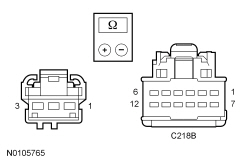 | Yes
GO to C3 . No INSTALL a new steering wheel. REFER to Section 211-04 . | ||||||||||||||||||||||||
| C3 TEST THE CLOCKSPRING INTERNAL PADDLE SHIFTER CIRCUITS FOR AN OPEN | |||||||||||||||||||||||||
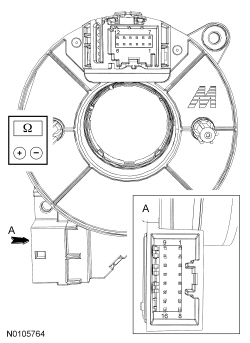 | Yes
REPAIR the circuit in question between clockspring C218A and the PCM connector for an open. No INSTALL a new clockspring. REFER to Section 501-20B . | ||||||||||||||||||||||||
| C4 TEST THE PADDLE SHIFTER SIGNAL CIRCUITS FOR A SHORT TO GROUND | |||||||||||||||||||||||||
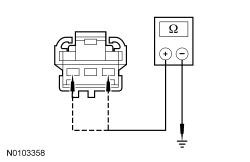 | Yes
GO to C6 . No GO to C5 . | ||||||||||||||||||||||||
| C5 TEST THE STEERING WHEEL WIRING HARNESS PADDLE SHIFTER SIGNAL CIRCUITS FOR A SHORT TO GROUND | |||||||||||||||||||||||||
 | Yes
REPAIR the circuit in question between clockspring C218A and the PCM connector for a short. No INSTALL a new steering wheel. REFER to Section 211-04 . | ||||||||||||||||||||||||
| C6 CHECK THE PADDLE SHIFTER | |||||||||||||||||||||||||
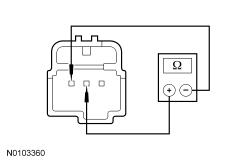 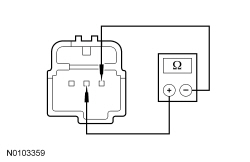 | Yes
INSTALL a new PCM. REFER to Section 303-14 . RECONNECT all components. TEST the system for normal operation. No INSTALL a new paddle shifter. REFER to Selector Lever — Paddle Shift in this section. |